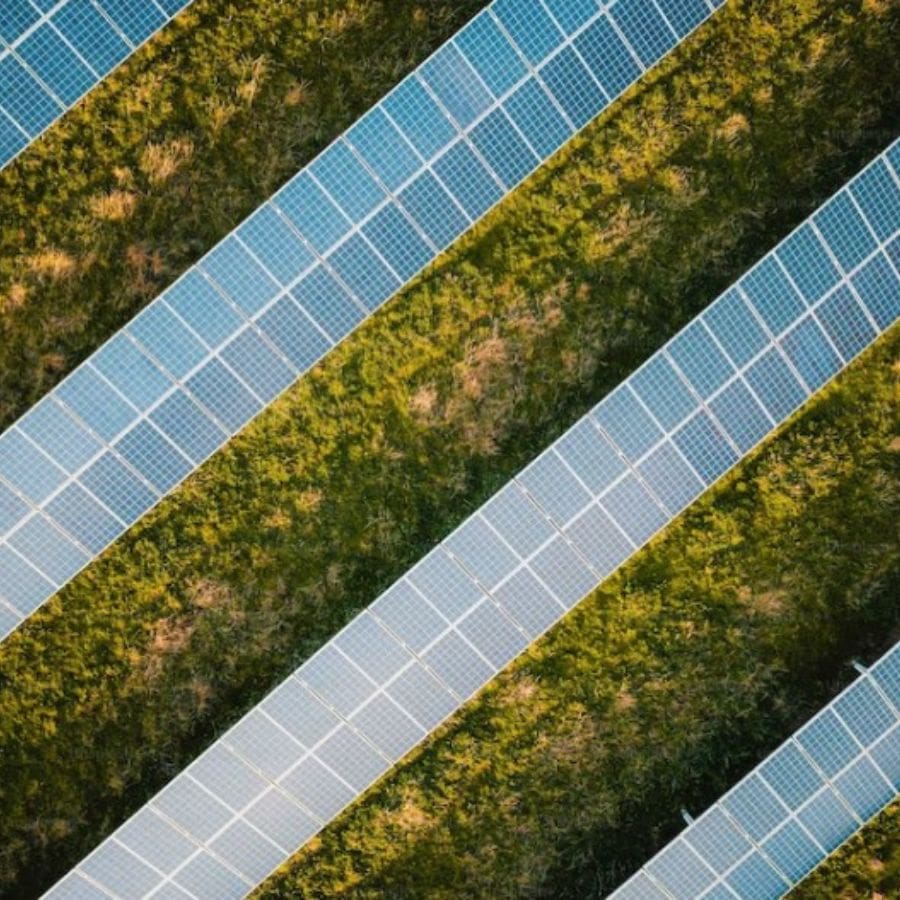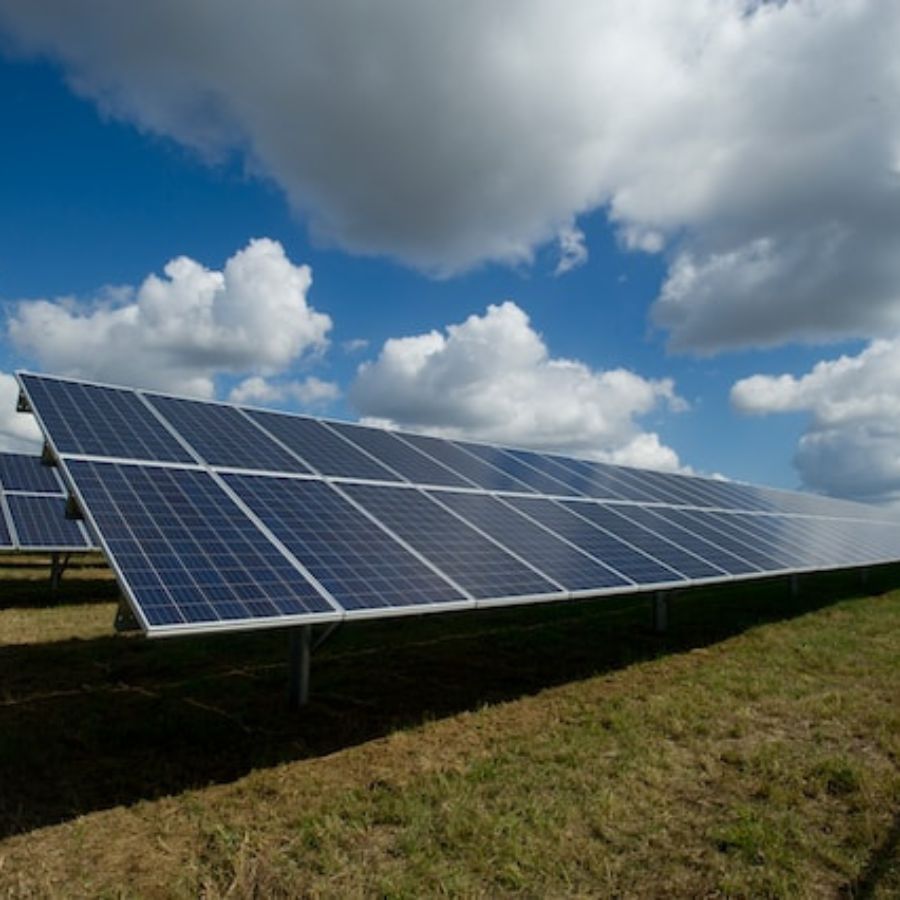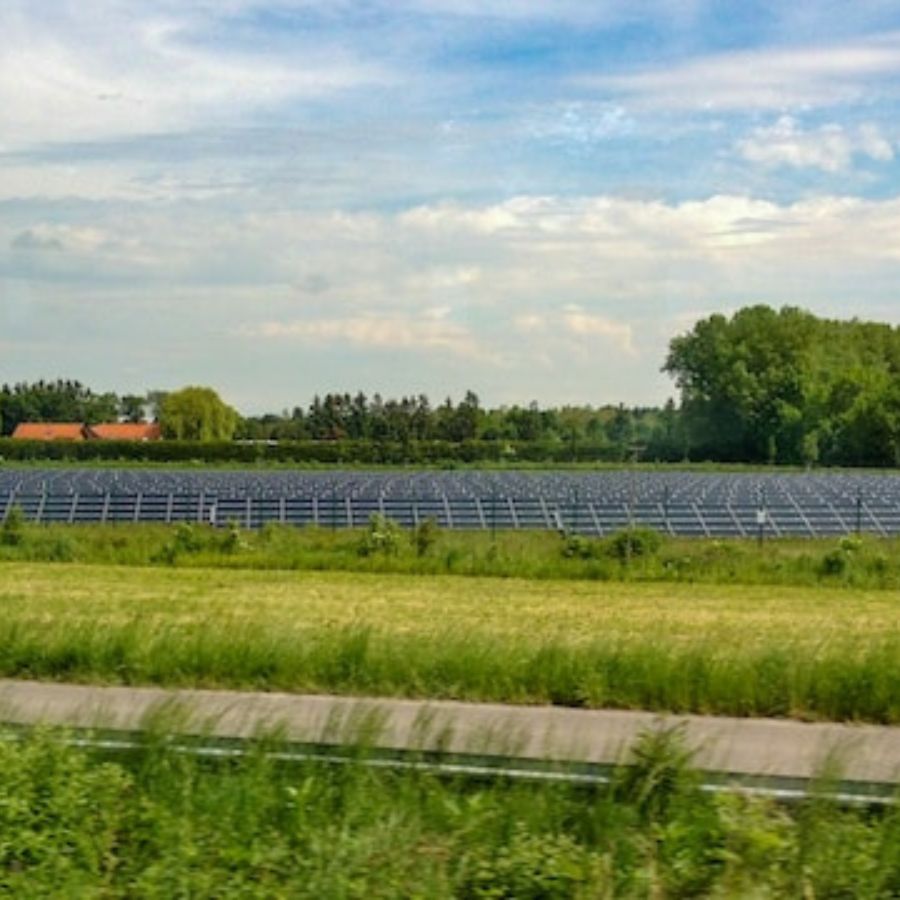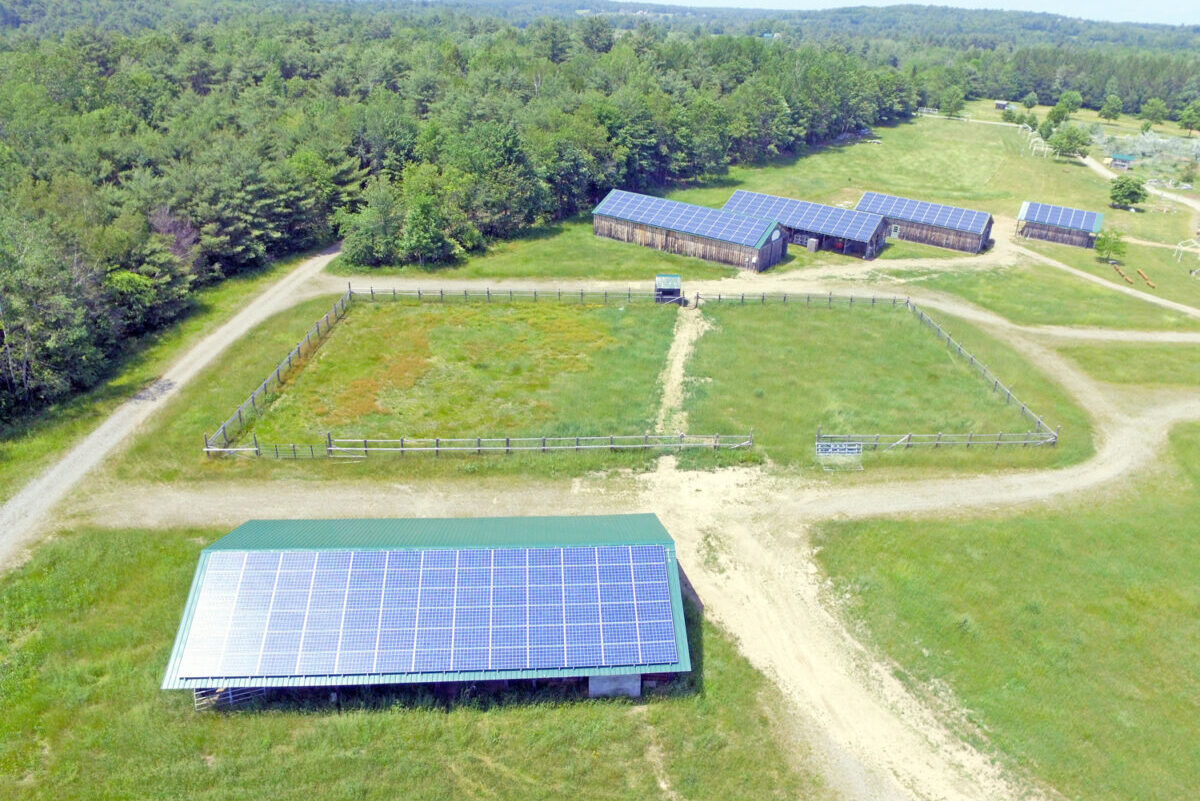As the world seeks sustainable solutions to combat climate change and ensure food security, innovative approaches such as agrivoltaics have emerged. Agrivoltaics, also known as solar farming or agro photovoltaics, combines agricultural practices with solar energy production. This symbiotic relationship allows for the simultaneous cultivation of crops and renewable energy generation.
In this article, we will explore the concept of agrivoltaics, its benefits, and its relevance to Canada’s agricultural sector. We will draw information from government and educational sources.
Understanding Agrivoltaics

Agrivoltaics is an innovative approach that involves the installation of solar panels or photovoltaic panels above agricultural fields. This setup serves a dual purpose, providing shade for crops and generating clean, sustainable energy. In addition, agrivoltaics utilize the same land for agriculture and solar energy production. It helps to optimize resource usage and offers several benefits to both sectors. The solar panels, also known as solar arrays or photovoltaic systems, are mounted on structures above the crops. They capture sunlight and convert it into electricity through the photovoltaic process. This clean energy can be used on-site or fed into the grid. It contributes to a renewable energy supply.
One of the critical advantages of agrivoltaics is the optimization of land productivity. By using the available land for both agricultural cultivation and solar energy generation, farmers can make the most efficient use of their resources. The shade provided by the solar panels offers several benefits to the crops. It helps regulate temperature, reducing plants’ risk of heat stress and sunburn. Additionally, the shade can minimize water evaporation, improving water efficiency in irrigation practices.
Benefits of Agrivoltaics
Increased Land Productivity
Agrivoltaics offers a unique advantage by maximizing land productivity using land for agriculture and solar energy generation. By installing solar panel modules above agricultural fields, agrivoltaics optimizes resource usage and provides several benefits to crop cultivation.
The shade provided by the solar panels in an agrivoltaic system plays a crucial role in regulating temperature and reducing water evaporation. This shade effectively creates a microclimate that promotes optimal conditions for crop growth. By shielding the crops from direct sunlight, agrivoltaics mitigates the risk of heat stress and sunburn. They can negatively impact plant health and productivity. Additionally, the shade helps conserve soil moisture. They reduce the need for excessive irrigation and promote water efficiency.
Moreover, an agrivoltaic solar panel setup can be a physical barrier. It can offer protection against adverse weather conditions. Hail or heavy rain can cause significant damage to crops. However, the presence of solar panels above the fields provides a shield. It minimizes the impact of these weather events. The protection ensures the preservation of crop quality and reduces the risk of crop losses.
Energy Generation and Grid Independence
Agrivoltaic systems play a crucial role in generating renewable energy, offering a sustainable alternative to fossil fuel reliance and aiding in reducing greenhouse gas emissions. In Canada, solar energy potential varies across regions. Agrivoltaics can be particularly beneficial in areas where traditional solar farms may not be feasible due to various factors. This decentralized energy generation has the potential to enhance energy security. Besides, it also provides unique opportunities for farmers to become energy producers.
By integrating solar energy systems into agricultural land, agrivoltaics harness the power of the sun to generate clean electricity. Installing photovoltaic (PV) panels above crops enables simultaneous energy production alongside agricultural activities. This dual-purpose approach maximizes the utilization of land and resources. It contributes to a more sustainable and efficient system.
In Canada, factors such as land availability, cost, or geographic considerations may limit the feasibility of traditional solar development. However, agrivoltaics presents a promising solution by utilizing existing agricultural land for solar energy production. This approach expands the potential for solar technology deployment across diverse regions. Furthermore, it leverages solar resources that were previously untapped.
Agrivoltaics also contribute to energy independence and grid resilience. Farmers can reduce dependence on external energy sources by generating renewable energy on-site. It enhances their energy security. Excess electricity produced by agrivoltaic systems can go back into the grid. That helps reduce the overall energy demand and promotes a more sustainable energy mix.
Pilot projects and research initiatives in Canada have explored the potential of agrivoltaics in energy generation. These projects have demonstrated the viability of integrating solar panels with agricultural activities. They highlighted the benefits of decentralized energy production. Agrivoltaics empower farmers to participate actively in the renewable energy sector. In addition, agrivoltaics fosters a transition towards a more sustainable and resilient energy system.
Diversification of Income
Integrating solar technology with agricultural operations in agrivoltaics enhances sustainable energy production. It also enables farmers to diversify their income streams. By incorporating photovoltaic plants or solar installations into their farms, farmers can generate additional revenue. The extra payment is through electricity production and associated incentives, such as feed-in tariffs or net metering programs. This economic diversification offers financial stability and resilience, particularly in the face of climate-related challenges.
Traditionally, farmers rely on crop revenues as their primary income source. However, agrivoltaics presents an opportunity to supplement this income through solar energy generation. Farmers can optimize resource usage and maximize their potential earnings. They can utilize the same land for both agricultural and solar activities to do so. One can sell the electricity generated through solar panels back to the grid, providing an additional source of income.
Moreover, agrivoltaics allow farmers to use various incentives and support mechanisms. Feed-in tariffs and net metering programs incentivize renewable energy production and can provide a steady income stream. Feed-in tariffs guarantee a fixed payment for the electricity generated. At the same time, net metering allows farmers to offset their energy consumption. In addition, it helps to earn credits or charges for the excess energy they feed into the grid.
This diversification of income is particularly valuable in the face of climate-related challenges. As extreme weather events become more frequent, agricultural productivity may be affected. Agrivoltaics offer an opportunity for farmers to mitigate risks and enhance their financial resilience. The combination of agriculture and solar energy generation reduces the reliance on a single income source. It provides a buffer against potential crop losses.
Agrivoltaics in Canada

With its vast agricultural land and growing renewable energy sector, Canada holds immense potential for agrivoltaics. Several provinces and organizations have recognized the benefits of this innovative approach. They are actively exploring its implementation.
Alberta Agriculture and Forestry
The Government of Alberta acknowledges the potential of agrivoltaics as a sustainable agricultural practice. They recognize solar panels’ benefits in various agricultural sector applications. For instance, they highlight the opportunity to use solar panels to provide shade for livestock during grazing, reducing heat stress and enhancing animal welfare. This application demonstrates the versatility of agrivoltaics in promoting sustainable livestock management practices.
Additionally, integrating solar panels with irrigation systems is a valuable water management strategy, particularly in arid regions. By shading the ground and reducing direct sunlight exposure, agrivoltaics can help minimize water evaporation from the soil. This water-saving approach aligns with the government’s focus on efficient water use in agricultural operations.
The recognition of agrivoltaics by the Government of Alberta highlights its potential as a sustainable and innovative approach within the province. Through pilot projects and ongoing research, agrivoltaics can further contribute to developing Alberta’s solar energy systems and sustainable agriculture. The government embraces solar development and supports the implementation of agrivoltaics. It aims to promote resource efficiency and foster a more sustainable agricultural sector.
Nova Scotia Department of Agriculture
The Nova Scotia Department of Agriculture recognizes the value of agrivoltaics in bolstering the resilience and viability of agricultural operations in the province. They highlight the benefits of using solar panels in agriculture. Such benefits include:
- extending the growing season
- protecting against extreme weather events
- increasing farm energy self-sufficiency
By endorsing agrivoltaics, the department emphasizes the potential for this innovative approach to enhance agricultural productivity and sustainability in Nova Scotia.
Research Initiatives
Canadian educational institutions are at the forefront of agrivoltaics research. They are actively exploring the potential of combining solar energy production with agricultural practices. One notable example is the University of British Columbia’s Faculty of Land and Food Systems. It has conducted studies on integrating solar panels with vegetable farming.
The University of British Columbia’s research focuses on understanding the effects of shade provided by solar panels on crop growth, soil moisture levels, and microclimate dynamics. By studying these factors, researchers gain valuable insights into optimizing agrivoltaic systems. That ensures optimal crop performance and resource utilization.
The findings from such research initiatives are essential for guiding future agrivoltaic implementations. They provide scientific evidence and practical knowledge to inform farmers, policymakers, and industry stakeholders. You learn about the potential benefits, challenges, and best practices of agrivoltaics.
By actively engaging in agrivoltaics research, Canadian educational institutions contribute to developing and advancing this innovative approach. Their efforts drive the adoption of sustainable agricultural practices and renewable energy generation. They are fostering a more resilient and sustainable agricultural sector in Canada.
Government Support
The Canadian government has demonstrated its support for agrivoltaics through various initiatives. One such program is the Agricultural Clean Technology Program (ACTP), administered by Agriculture and Agri-Food Canada. The ACTP offers funding and support to farmers and agricultural businesses to adopt innovative technologies, including agrivoltaics.
The primary objective of the ACTP is to accelerate the adoption of clean technologies in the agriculture sector. It includes projects that integrate renewable energy systems with agricultural practices, aligning with the goals of agrivoltaics. The government aims to encourage the implementation of agrivoltaic systems and promote sustainable agriculture. It does that by providing financial assistance and resources.
The Canadian government’s support facilitates the adoption of agrivoltaics. It acknowledges its potential in advancing sustainable agricultural practices and reducing greenhouse gas emissions. Through programs like the ACTP, the government plays a crucial role in promoting the integration of renewable energy systems, such as agrivoltaics, within the agricultural sector.
Case Studies
Several successful agrivoltaic projects in Canada are compelling examples of this approach’s viability and benefits. Among them is the Gull Lake Solar Project in Saskatchewan. It seamlessly combines solar power generation with crop cultivation, focusing on canola farming.
In the Gull Lake Solar Project, solar panels are in strategic places to shade the canola crops. This shading effect has proven beneficial, increasing crop yields and reducing water usage. The panels not only generate clean energy but also create a microclimate that fosters optimal growing conditions for the crops.
The success of the Gull Lake Solar Project serves as a testament to the potential of agrivoltaics in the Canadian context. It demonstrates the ability to maximize land utilization, generate renewable energy, and enhance agricultural productivity simultaneously. The project highlights the advantages of integrating solar power with agriculture and sets a precedent for future agrivoltaic initiatives in Canada.
By showcasing the practical application and positive outcomes of agrivoltaics through case studies like the Gull Lake Solar Project, stakeholders, and policymakers can recognize the potential benefits of this approach. It can further promote its adoption in Canada’s agricultural sector.
Climate Resilience
In the face of climate change and its associated challenges, agrivoltaics offers a valuable tool for building climate resilience in Canadian agriculture. With the increasing frequency and intensity of extreme weather events like droughts, heat waves, and storms, agrivoltaics can provide a crucial shield for crops. In addition, agrivoltaics mitigate the impacts of these weather conditions. The shade provided by solar panels helps regulate temperature, reducing heat stress on plants during heatwaves and protecting them from excessive sunlight.
By embracing agrivoltaics, farmers can enhance the resilience of their operations. Diversifying income streams through renewable energy generation allows them to adapt to changing climatic conditions. It reduces their reliance on traditional agricultural practices. Integrating solar panels supports crop productivity, reduces greenhouse gas emissions, and promotes sustainable farming practices.
Policy and Regulatory Considerations
For the widespread adoption of agrivoltaics in Canada, it is essential to establish supportive policy frameworks and regulatory guidelines. Collaboration among federal, provincial, and municipal governments is crucial to develop regulations that facilitate the implementation of agrivoltaic projects.
To encourage the integration of agrivoltaics, governments can streamline permitting processes and ensure efficient approval mechanisms for farmers. Net metering policies allow farmers to offset their energy consumption and earn credits or payments for the excess energy they feed into the grid. They can incentivize the adoption of agrivoltaics.
Financial incentives, such as grants or tax credits, can further support farmers in implementing agrivoltaic systems. These incentives offset the initial investment costs and promote the economic viability of agrivoltaics.
Precise land use, system design, and maintenance guidelines are also essential. Farmers need a roadmap that outlines the considerations and requirements for integrating agrivoltaics into their agricultural operations. Governments can ensure that agrivoltaic projects adhere to best practices by providing comprehensive policies. Furthermore, they can also ensure that agrivoltaic projects optimize their environmental, social, and economic benefits.
Conclusion
Agrivoltaics represents a promising solution to address Canada’s challenges of sustainable agriculture and clean energy production. This innovative approach offers farmers increased land productivity, energy generation, and economic diversification. With the support of government agencies, ongoing research, and collaborative efforts, agrivoltaics has the potential to play a significant role in ensuring a resilient and sustainable future for Canada’s agricultural sector.
As the world transitions to a low-carbon economy, agrivoltaics can contribute to achieving Canada’s renewable energy targets while supporting food production and rural development. By harnessing the sun’s power and integrating it with agricultural practices, agrivoltaics offers a win-win solution for farmers, the environment, and energy systems. Continued research, investment, and policy support will be vital in unlocking the full potential of agrivoltaics in Canada. It helps in furthering sustainable agriculture and renewable energy production.









